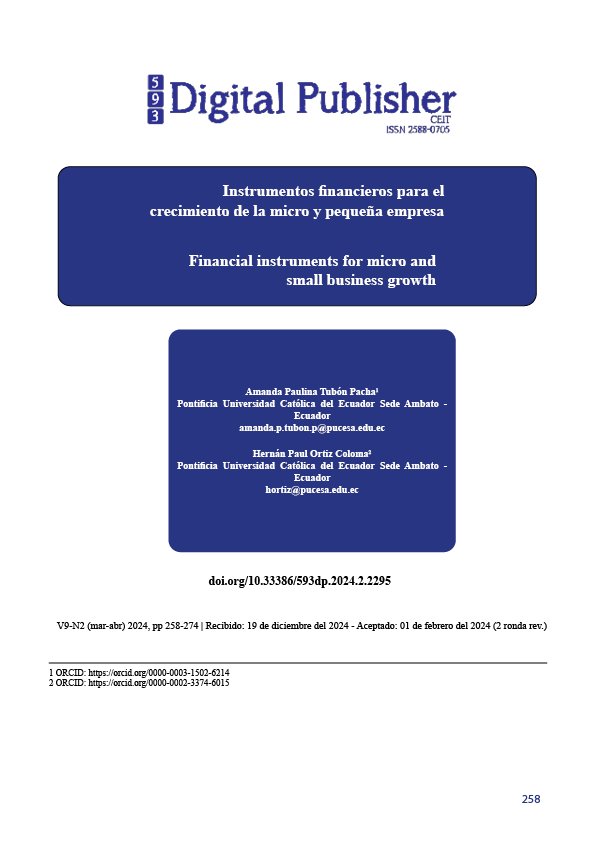Financial instruments for micro and small business growth
Main Article Content
Abstract
Currently, there is a need to determine the financial instruments that significantly favor the economic and financial growth of micro and small enterprises. In this context, the general objective focuses its attention on studying the financial instruments for the analysis of the economic growth of Micro and Small Enterprises (MiSE), taking as a case study the manufacturing sector of the province of Tungurahua. Under this argument, the application of IFRS 9 is remarkable for the educated development of this type of companies. For this purpose, a quantitative research was used, under an applied and practical methodological strategy. The interpretation of data from secondary sources was carried out through a descriptive scope. The sample consisted of 20 MiSEs from the manufacturing sector in the province of Tungurahua. The results show that 100% of the MiSEs apply IFRS, 70% of MiSEs have applied a business model strategically focused on preserving assets to receive their cash flows, 65% of MiSEs highlight a high level of compliance with IFRS 9, 65% of S MiSEs do not register any inconvenience in the accounting record of financial assets, 60% presented a high effect on debt instruments under the new accounting regulations, and 55% of MiSEs present important changes with respect to the accounting uniformity principle. It is concluded that the application of IFRS 9 allows users of financial statements a better understanding, application and interpretation. Applying IFRS 9 helped to simplify and methodically improve the accounting for financial instruments by eloquently reducing the accounting asymmetries that would arise due to the business model
Downloads
Article Details

This work is licensed under a Creative Commons Attribution-NonCommercial-ShareAlike 4.0 International License.
1. Derechos de autor
Las obras que se publican en 593 Digital Publisher CEIT están sujetas a los siguientes términos:
1.1. 593 Digital Publisher CEIT, conserva los derechos patrimoniales (copyright) de las obras publicadas, favorece y permite la reutilización de las mismas bajo la licencia Licencia Creative Commons 4.0 de Reconocimiento-NoComercial-CompartirIgual 4.0, por lo cual se pueden copiar, usar, difundir, transmitir y exponer públicamente, siempre que:
1.1.a. Se cite la autoría y fuente original de su publicación (revista, editorial, URL).
1.1.b. No se usen para fines comerciales u onerosos.
1.1.c. Se mencione la existencia y especificaciones de esta licencia de uso.
References
Benkraiem, R., Bensaad, I., & Lakhal, F. (2022). How do International Financial Reporting Standards affect information asymmetry? The importance of the earnings quality channel. Journal of International Accounting, Auditing and Taxation, 46, 100445. https://doi.org/https://doi.org/10.1016/j.intaccaudtax.2021.100445
Betancourt, A., & Caviedes, I. (2018). Metodología de correlación estadística de un sistema integrado de gestión de la calidad en el sector salud. Signos: Investigación en sistemas de gestión, 10(2), 119-139.
Carè, R., & Weber, O. (2023). How much finance is in climate finance? A bibliometric review, critiques, and future research directions. Research in International Business and Finance, 64, 101886. https://doi.org/https://doi.org/10.1016/j.ribaf.2023.101886
Compaoré, A. (2022). Access-for-all to financial services: Non-resources tax revenue-harnessing opportunities in developing countries. Quarterly Review of Economics and Finance, 85, 236-245. https://doi.org/10.1016/j.qref.2022.03.007
Guan, J., Xu, H., Huo, D., Hua, Y., & Wang, Y. (2021). Economic policy uncertainty and corporate innovation : Evidence from China. Pacific-Basin Finance Journal, 67(September 2020), 101542. https://doi.org/10.1016/j.pacfin.2021.101542
Gutierrez, S., Osorio, H., & Romero-Meza, R. (2018). NIIF 9 (IFRS 9) Instrumentos Financieros: Aplicación Práctica para Determinación de Pérdida Esperada de Carteras de Activos Financieros. XXXIV Encuentro Nacional de Escuelas y Facultades de Administración (ENEFA), 9(Ifrs 9), 2-29.
Hellmann, A., & Patel, C. (2021). Translation of International Financial Reporting Standards and implications for judgments and decision-making. Journal of Behavioral and Experimental Finance, 30, 100479. https://doi.org/https://doi.org/10.1016/j.jbef.2021.100479
Ibujés-Villacís, J. M., & Benavides-Pazmiño, M. A. (2018). Contribución de la tecnología a la productividad de las pymes de la industria textil en Ecuador. Cuadernos de Economía, 41(115), 140-150. https://doi.org/https://doi.org/10.1016/j.cesjef.2017.05.002
Lozada, J. (2014). Investigación Aplicada: Definición, Propiedad Intelectual e Industria. Cienciaamérica, 1(3), 34-39.
Malaquias, R. F., & Zambra, P. (2018). Disclosure of financial instruments: Practices and challenges of Latin American firms from the mining industry. Research in International Business and Finance, 45, 158-167. https://doi.org/https://doi.org/10.1016/j.ribaf.2017.07.144
Martínez, A. P., Jara-Alvear, J., Andrade, R. J., & Icaza, D. (2023). Sustainable development indicators for electric power generation companies in Ecuador: A case study. Utilities Policy, 81, 101493. https://doi.org/https://doi.org/10.1016/j.jup.2023.101493
Morales-Díaz, J. (2019). La última reforma de las NIIF y sus efectos en los estados financieros. Estudios de Economía Aplicada, 36(2), 349. https://doi.org/10.25115/eea.v36i2.2534
Muyulema-Allaica, C. A., Muyulema-Allaica, J. C., Pucha-Medina, P. M., & Ocaña-Parra, S. V. (2020). Los costos de producción y su incidencia en la rentabilidad de una empresa avícola integrada del Ecuador: caso de estudio. Visionario Digital, 4(1). https://doi.org/10.33262/visionariodigital.v4i1.1089
Nurunnabi, M. (2014). ‘Does accounting regulation matter?’: An experience of international financial reporting standards implementation in an emerging country. Research in Accounting Regulation, 26(2), 230-238. https://doi.org/https://doi.org/10.1016/j.racreg.2014.09.012
Parrales-Choez, C. G., & Castillo-Llanos, F. D. (2018). Análisis de NIIF 9 - Instrumentos Financieros desde una perspectiva industrial. Contabilidad y Negocios, 13(25), 6-19. https://doi.org/10.18800/contabilidad.201801.001
Pignatel, I., & Tchakoute-Tchuigoua, H. (2020). Microfinance institutions and International Financial Reporting Standards: An exploratory analysis. Research in International Business and Finance, 54, 101309. https://doi.org/https://doi.org/10.1016/j.ribaf.2020.101309
Pucha, M. P., Muyulema, J. C., Burgos, Arcos, C., & Buenaño., E. N. (2019). Gestión de la calidad como estructura del desempeño operacional en el sector Cooperativo Financiero del segmento cinco de la provincia de Chimborazo. Dilemas contemporáneos. Educación, política y valores, 6(2), 1-29.
Quiñonez-Alvarado, E. S., Lozano-Robles, M. de J., & Romero-Villagrán, J. L. (2021). Normas Internacionales de Información Financiera (NIIF 9), medición y clasificación de los instrumentos financieros. Revista Publicando, 8(31), 194-206. https://doi.org/https://doi.org/10.51528/rp.vol8.id2244
Raju, G. S., Vanteru, M. K., & Naik, A. C. (2021). Lean manufacturing for SMEs - A study with reference to SMEs. AIP Conference Proceedings, 2317(February). https://doi.org/10.1063/5.0036131
Rojas, G., Arevalo, Y., & Gutierrez, N. (2020). Propuesta metodológica para calcular pérdidas crediticias esperadas, utilizando el método simple de la NIIF 9. 593 Digital Publisher CEIT, 5(6-1), 175-184. https://doi.org/10.33386/593dp.2020.6-1.391
Romero-Meza, R., Gutiérrez-Caripán, S., & Osorio-Gómez, H. (2018). NIIF 9 instrumentos financieros: aplicación práctica para la determinación de la pérdida esperada de un portafolio de activos. Capic Review, 16, 1-18. https://doi.org/https://doi.org/10.35928/cr.vol16.2018.78
Ron, R., & Sacoto, V. (2017). Las Pymes ecuatorianas: su impacto en el empleo como contribución del Pib Pymes al Pib total. Espacios, 38, 15.
Sánchez-Macías, R. A., Pucha-Medina, P. M., Usca-Veloz, R. B., Espinosa-Ruiz, C. G., Velasteguí-Bósquez, G. A., & Muyulema-Allaica, J. C. (2020). Las finanzas sostenibles. Retos actuales hacia el desarrollo del sector cooperativo popular y solidario ecuatoriano. RIIIT. Revista Internacional de Investigación e Innovación Tecnológica, 7(42), 1-21.
Uquillas, A. (2022). Demanda por crédito en Ecuador: ¿Qué trabajadores necesitan con mayor urgencia un crédito, para reactivar su economía, en el contexto de la crisis sanitaria COVID-19? Revista Cuestiones Económicas, 32(1), 5-31. https://doi.org/https://doi.org/10.47550/RCE/32.1.1
Ur, M., Sensoy, A., Eraslan, V., Hussain, S. S. J., & Vinh, V. X. (2021). North American Journal of Economics and Finance Sensitivity of US equity returns to economic policy uncertainty and investor sentiments. North American Journal of Economics and Finance, 57(1), 101392. https://doi.org/10.1016/j.najef.2021.101392
Wang, J., Lyu, Y., Zhang, H., Jing, R., Lai, X., Feng, H., Knoll, M. D., & Fang, H. (2021). Willingness to pay and financing preferences for COVID-19 vaccination in China. Vaccine, 39(14), 1968-1976. https://doi.org/https://doi.org/10.1016/j.vaccine.2021.02.060
Zambrano, F. J., Sánchez, M. E., & Correa, S. R. (2021). Analysis of profitability, indebtedness and liquidity of microenterprises in Ecuador. Retos, 11(22), 235-249.
Zhang, J., Zhang, Y., & Sun, Y. (2022). Restart economy in a resilient way: The value of corporate social responsibility to firms in COVID-19. Finance Research Letters, December 2021, 102683. https://doi.org/10.1016/j.frl.2022.102683



